Analysis of COVID-19 Economic Stimulus Packages: A Case Study
VerifiedAdded on 2023/01/11
|13
|4234
|87
Case Study
AI Summary
This case study analyzes the economic stimulus packages implemented by the Australian government in response to the COVID-19 pandemic. It examines the government's rapid and comprehensive response, including fiscal measures such as direct spending, loan guarantees, and tax incentives aimed at supporting businesses, families, and individuals. The study explores the impact of these measures, along with the monetary policies implemented by the Reserve Bank of Australia (RBA), such as lowering interest rates and providing term funding. It also investigates the targeting of specific groups and demographics, the role of macroeconomic factors, potential obstacles to the fiscal strategy's effectiveness, the consequences of large stimulus packages, and the comparative effectiveness of Keynesian versus classical policies. Furthermore, the case study assesses the impact of the Australian dollar's volatility and the effects of asset price deflation on the economy.
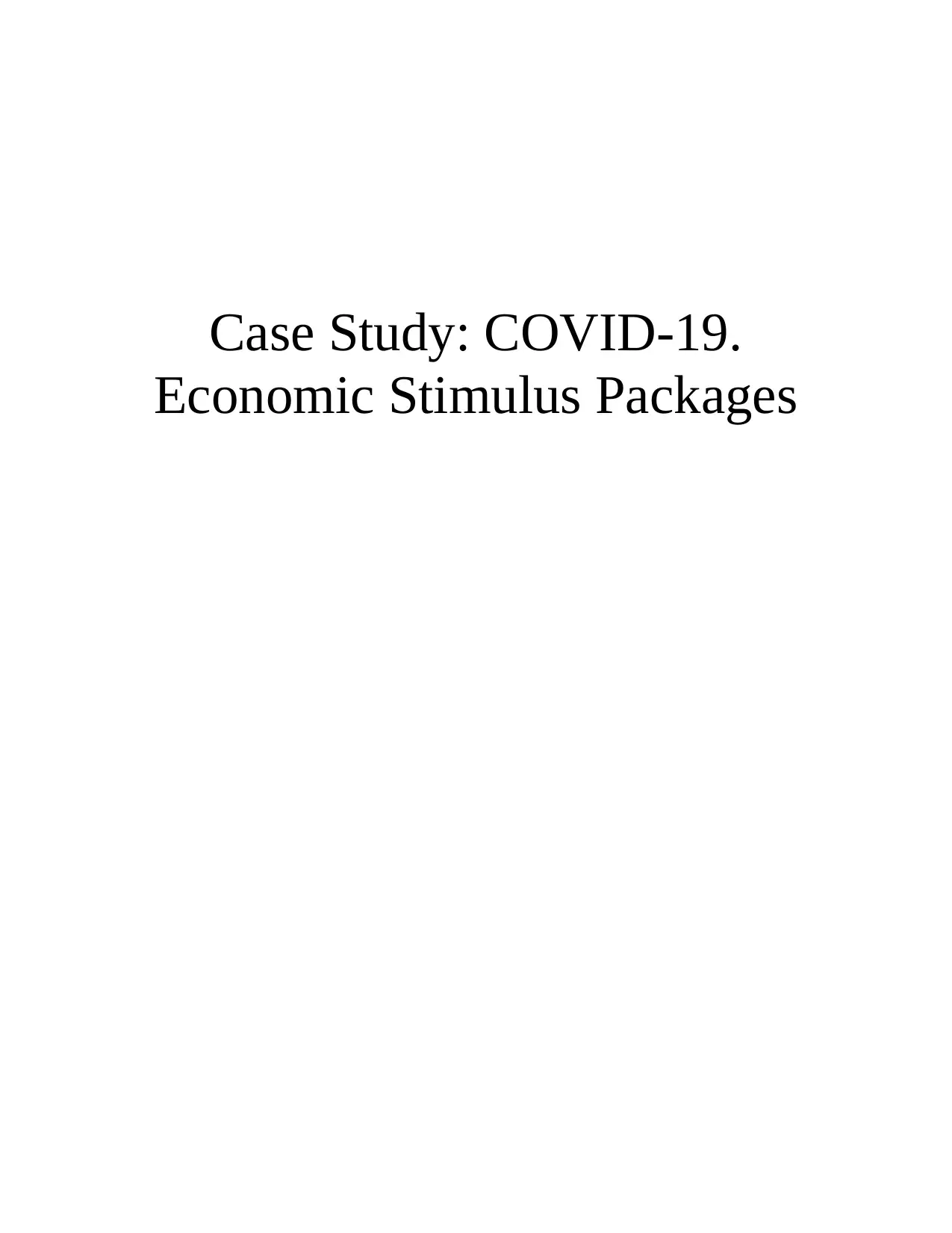
Case Study: COVID-19.
Economic Stimulus Packages
Economic Stimulus Packages
Paraphrase This Document
Need a fresh take? Get an instant paraphrase of this document with our AI Paraphraser
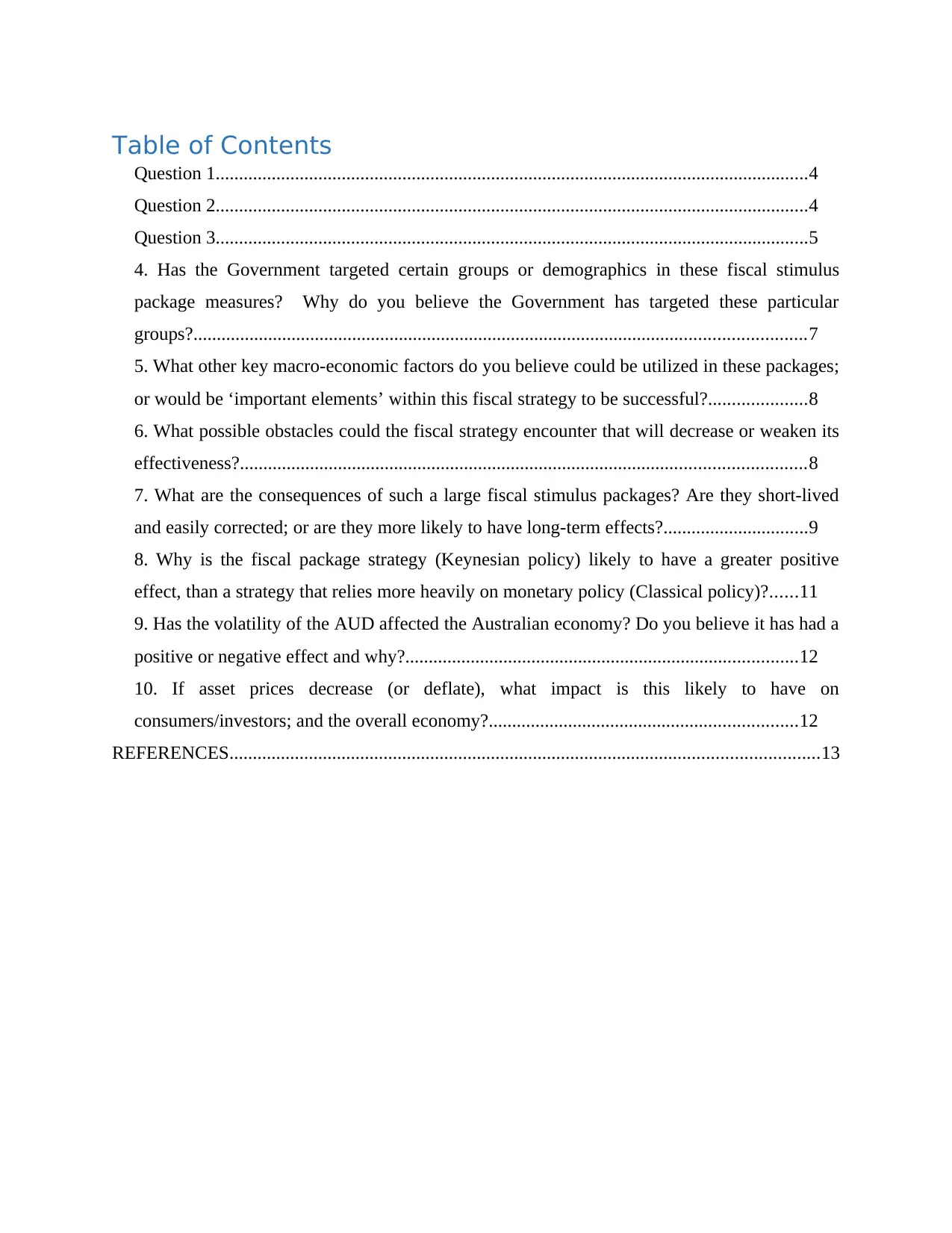
Table of Contents
Question 1...............................................................................................................................4
Question 2...............................................................................................................................4
Question 3...............................................................................................................................5
4. Has the Government targeted certain groups or demographics in these fiscal stimulus
package measures? Why do you believe the Government has targeted these particular
groups?...................................................................................................................................7
5. What other key macro-economic factors do you believe could be utilized in these packages;
or would be ‘important elements’ within this fiscal strategy to be successful?.....................8
6. What possible obstacles could the fiscal strategy encounter that will decrease or weaken its
effectiveness?.........................................................................................................................8
7. What are the consequences of such a large fiscal stimulus packages? Are they short-lived
and easily corrected; or are they more likely to have long-term effects?...............................9
8. Why is the fiscal package strategy (Keynesian policy) likely to have a greater positive
effect, than a strategy that relies more heavily on monetary policy (Classical policy)?......11
9. Has the volatility of the AUD affected the Australian economy? Do you believe it has had a
positive or negative effect and why?....................................................................................12
10. If asset prices decrease (or deflate), what impact is this likely to have on
consumers/investors; and the overall economy?..................................................................12
REFERENCES..............................................................................................................................13
Question 1...............................................................................................................................4
Question 2...............................................................................................................................4
Question 3...............................................................................................................................5
4. Has the Government targeted certain groups or demographics in these fiscal stimulus
package measures? Why do you believe the Government has targeted these particular
groups?...................................................................................................................................7
5. What other key macro-economic factors do you believe could be utilized in these packages;
or would be ‘important elements’ within this fiscal strategy to be successful?.....................8
6. What possible obstacles could the fiscal strategy encounter that will decrease or weaken its
effectiveness?.........................................................................................................................8
7. What are the consequences of such a large fiscal stimulus packages? Are they short-lived
and easily corrected; or are they more likely to have long-term effects?...............................9
8. Why is the fiscal package strategy (Keynesian policy) likely to have a greater positive
effect, than a strategy that relies more heavily on monetary policy (Classical policy)?......11
9. Has the volatility of the AUD affected the Australian economy? Do you believe it has had a
positive or negative effect and why?....................................................................................12
10. If asset prices decrease (or deflate), what impact is this likely to have on
consumers/investors; and the overall economy?..................................................................12
REFERENCES..............................................................................................................................13
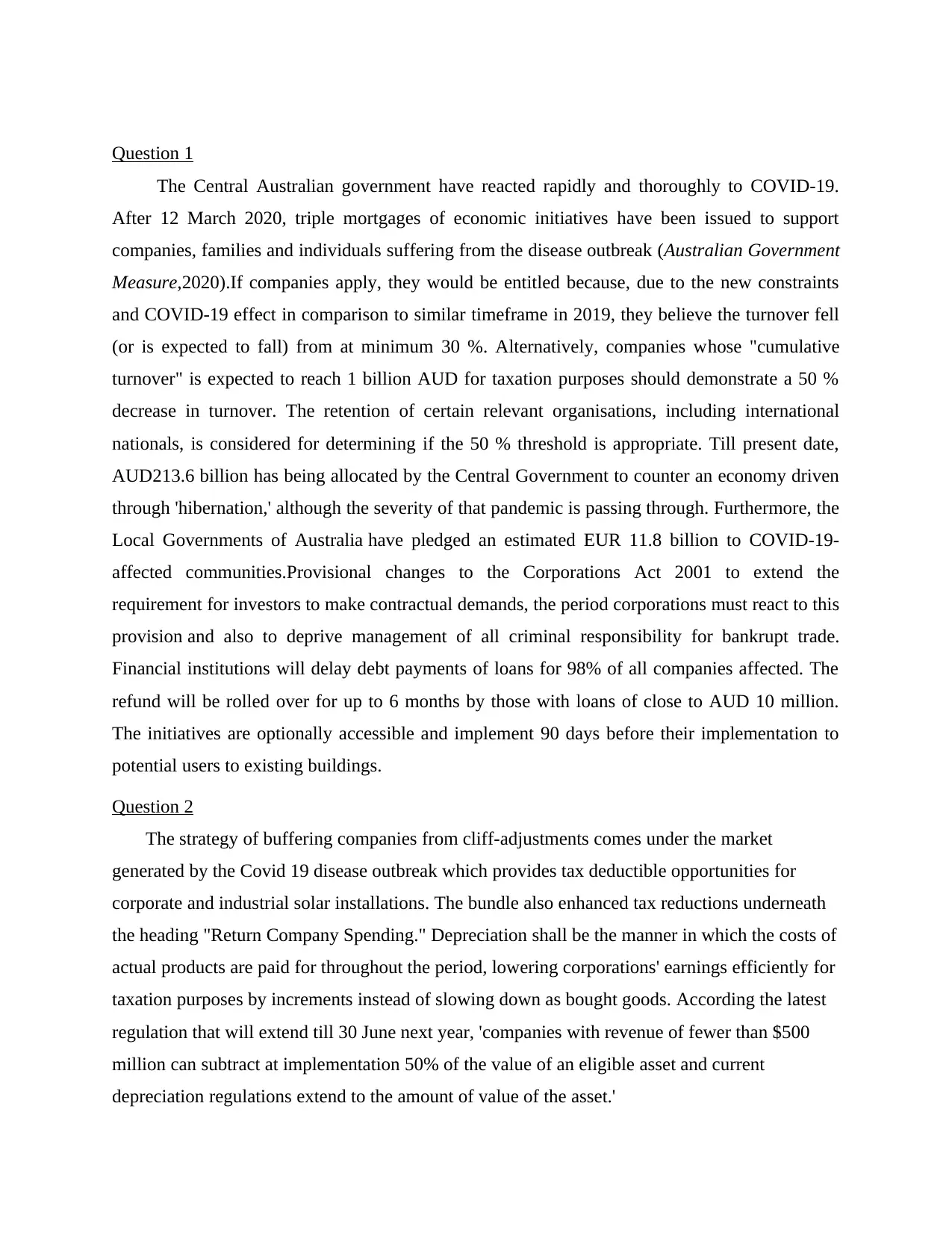
Question 1
The Central Australian government have reacted rapidly and thoroughly to COVID-19.
After 12 March 2020, triple mortgages of economic initiatives have been issued to support
companies, families and individuals suffering from the disease outbreak (Australian Government
Measure,2020).If companies apply, they would be entitled because, due to the new constraints
and COVID-19 effect in comparison to similar timeframe in 2019, they believe the turnover fell
(or is expected to fall) from at minimum 30 %. Alternatively, companies whose "cumulative
turnover" is expected to reach 1 billion AUD for taxation purposes should demonstrate a 50 %
decrease in turnover. The retention of certain relevant organisations, including international
nationals, is considered for determining if the 50 % threshold is appropriate. Till present date,
AUD213.6 billion has being allocated by the Central Government to counter an economy driven
through 'hibernation,' although the severity of that pandemic is passing through. Furthermore, the
Local Governments of Australia have pledged an estimated EUR 11.8 billion to COVID-19-
affected communities.Provisional changes to the Corporations Act 2001 to extend the
requirement for investors to make contractual demands, the period corporations must react to this
provision and also to deprive management of all criminal responsibility for bankrupt trade.
Financial institutions will delay debt payments of loans for 98% of all companies affected. The
refund will be rolled over for up to 6 months by those with loans of close to AUD 10 million.
The initiatives are optionally accessible and implement 90 days before their implementation to
potential users to existing buildings.
Question 2
The strategy of buffering companies from cliff-adjustments comes under the market
generated by the Covid 19 disease outbreak which provides tax deductible opportunities for
corporate and industrial solar installations. The bundle also enhanced tax reductions underneath
the heading "Return Company Spending." Depreciation shall be the manner in which the costs of
actual products are paid for throughout the period, lowering corporations' earnings efficiently for
taxation purposes by increments instead of slowing down as bought goods. According the latest
regulation that will extend till 30 June next year, 'companies with revenue of fewer than $500
million can subtract at implementation 50% of the value of an eligible asset and current
depreciation regulations extend to the amount of value of the asset.'
The Central Australian government have reacted rapidly and thoroughly to COVID-19.
After 12 March 2020, triple mortgages of economic initiatives have been issued to support
companies, families and individuals suffering from the disease outbreak (Australian Government
Measure,2020).If companies apply, they would be entitled because, due to the new constraints
and COVID-19 effect in comparison to similar timeframe in 2019, they believe the turnover fell
(or is expected to fall) from at minimum 30 %. Alternatively, companies whose "cumulative
turnover" is expected to reach 1 billion AUD for taxation purposes should demonstrate a 50 %
decrease in turnover. The retention of certain relevant organisations, including international
nationals, is considered for determining if the 50 % threshold is appropriate. Till present date,
AUD213.6 billion has being allocated by the Central Government to counter an economy driven
through 'hibernation,' although the severity of that pandemic is passing through. Furthermore, the
Local Governments of Australia have pledged an estimated EUR 11.8 billion to COVID-19-
affected communities.Provisional changes to the Corporations Act 2001 to extend the
requirement for investors to make contractual demands, the period corporations must react to this
provision and also to deprive management of all criminal responsibility for bankrupt trade.
Financial institutions will delay debt payments of loans for 98% of all companies affected. The
refund will be rolled over for up to 6 months by those with loans of close to AUD 10 million.
The initiatives are optionally accessible and implement 90 days before their implementation to
potential users to existing buildings.
Question 2
The strategy of buffering companies from cliff-adjustments comes under the market
generated by the Covid 19 disease outbreak which provides tax deductible opportunities for
corporate and industrial solar installations. The bundle also enhanced tax reductions underneath
the heading "Return Company Spending." Depreciation shall be the manner in which the costs of
actual products are paid for throughout the period, lowering corporations' earnings efficiently for
taxation purposes by increments instead of slowing down as bought goods. According the latest
regulation that will extend till 30 June next year, 'companies with revenue of fewer than $500
million can subtract at implementation 50% of the value of an eligible asset and current
depreciation regulations extend to the amount of value of the asset.'
⊘ This is a preview!⊘
Do you want full access?
Subscribe today to unlock all pages.

Trusted by 1+ million students worldwide
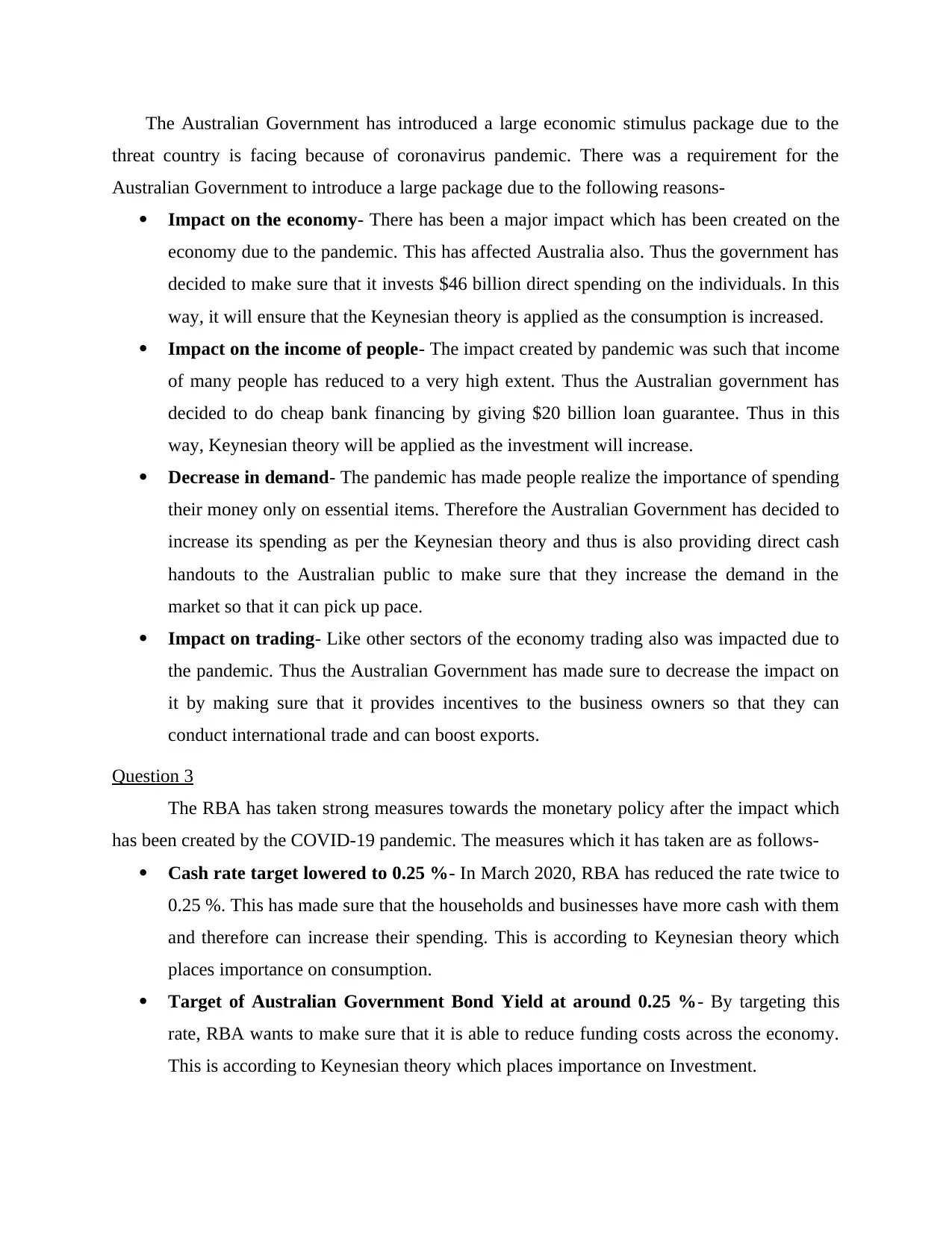
The Australian Government has introduced a large economic stimulus package due to the
threat country is facing because of coronavirus pandemic. There was a requirement for the
Australian Government to introduce a large package due to the following reasons-
Impact on the economy- There has been a major impact which has been created on the
economy due to the pandemic. This has affected Australia also. Thus the government has
decided to make sure that it invests $46 billion direct spending on the individuals. In this
way, it will ensure that the Keynesian theory is applied as the consumption is increased.
Impact on the income of people- The impact created by pandemic was such that income
of many people has reduced to a very high extent. Thus the Australian government has
decided to do cheap bank financing by giving $20 billion loan guarantee. Thus in this
way, Keynesian theory will be applied as the investment will increase.
Decrease in demand- The pandemic has made people realize the importance of spending
their money only on essential items. Therefore the Australian Government has decided to
increase its spending as per the Keynesian theory and thus is also providing direct cash
handouts to the Australian public to make sure that they increase the demand in the
market so that it can pick up pace.
Impact on trading- Like other sectors of the economy trading also was impacted due to
the pandemic. Thus the Australian Government has made sure to decrease the impact on
it by making sure that it provides incentives to the business owners so that they can
conduct international trade and can boost exports.
Question 3
The RBA has taken strong measures towards the monetary policy after the impact which
has been created by the COVID-19 pandemic. The measures which it has taken are as follows-
Cash rate target lowered to 0.25 %- In March 2020, RBA has reduced the rate twice to
0.25 %. This has made sure that the households and businesses have more cash with them
and therefore can increase their spending. This is according to Keynesian theory which
places importance on consumption.
Target of Australian Government Bond Yield at around 0.25 %- By targeting this
rate, RBA wants to make sure that it is able to reduce funding costs across the economy.
This is according to Keynesian theory which places importance on Investment.
threat country is facing because of coronavirus pandemic. There was a requirement for the
Australian Government to introduce a large package due to the following reasons-
Impact on the economy- There has been a major impact which has been created on the
economy due to the pandemic. This has affected Australia also. Thus the government has
decided to make sure that it invests $46 billion direct spending on the individuals. In this
way, it will ensure that the Keynesian theory is applied as the consumption is increased.
Impact on the income of people- The impact created by pandemic was such that income
of many people has reduced to a very high extent. Thus the Australian government has
decided to do cheap bank financing by giving $20 billion loan guarantee. Thus in this
way, Keynesian theory will be applied as the investment will increase.
Decrease in demand- The pandemic has made people realize the importance of spending
their money only on essential items. Therefore the Australian Government has decided to
increase its spending as per the Keynesian theory and thus is also providing direct cash
handouts to the Australian public to make sure that they increase the demand in the
market so that it can pick up pace.
Impact on trading- Like other sectors of the economy trading also was impacted due to
the pandemic. Thus the Australian Government has made sure to decrease the impact on
it by making sure that it provides incentives to the business owners so that they can
conduct international trade and can boost exports.
Question 3
The RBA has taken strong measures towards the monetary policy after the impact which
has been created by the COVID-19 pandemic. The measures which it has taken are as follows-
Cash rate target lowered to 0.25 %- In March 2020, RBA has reduced the rate twice to
0.25 %. This has made sure that the households and businesses have more cash with them
and therefore can increase their spending. This is according to Keynesian theory which
places importance on consumption.
Target of Australian Government Bond Yield at around 0.25 %- By targeting this
rate, RBA wants to make sure that it is able to reduce funding costs across the economy.
This is according to Keynesian theory which places importance on Investment.
Paraphrase This Document
Need a fresh take? Get an instant paraphrase of this document with our AI Paraphraser
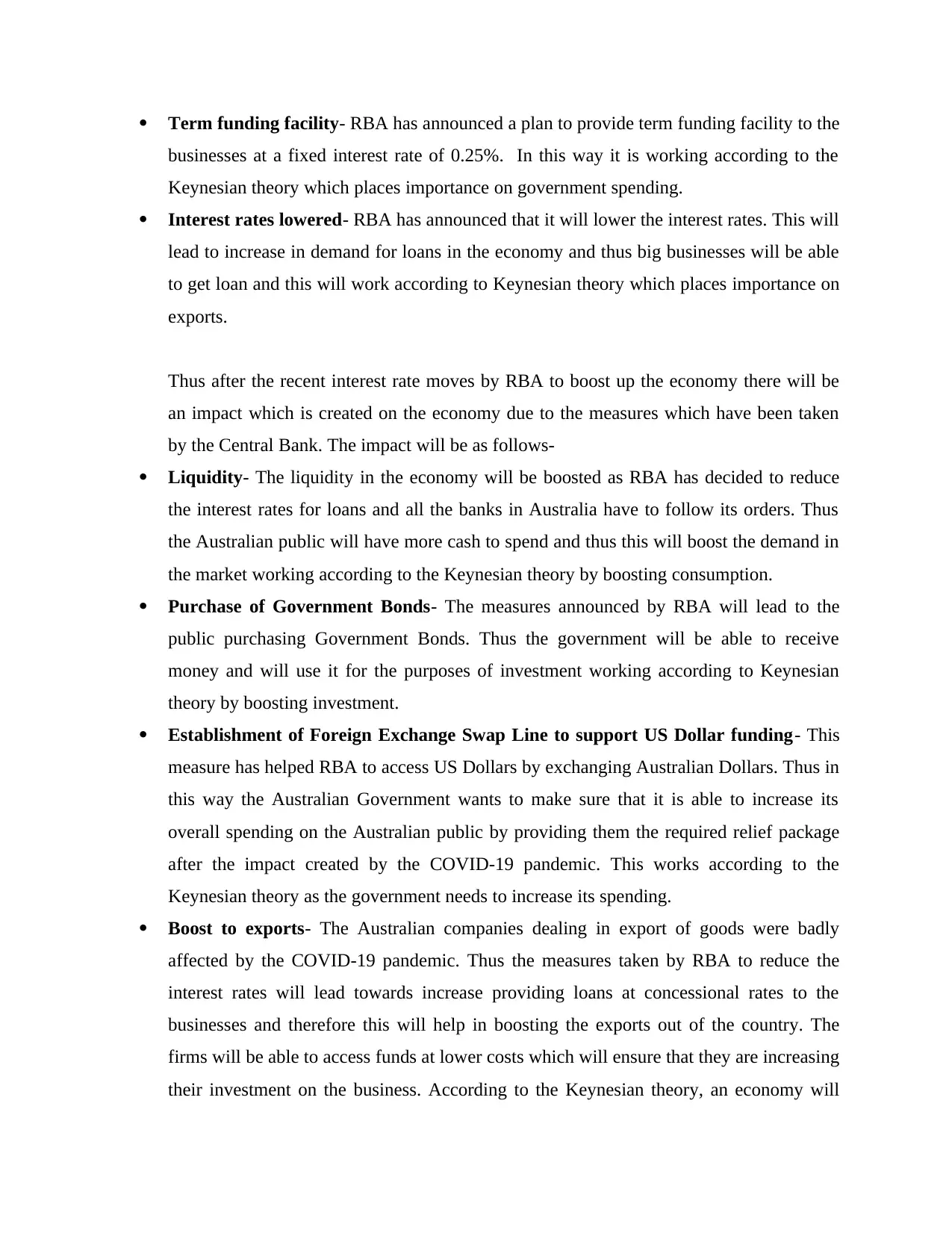
Term funding facility- RBA has announced a plan to provide term funding facility to the
businesses at a fixed interest rate of 0.25%. In this way it is working according to the
Keynesian theory which places importance on government spending.
Interest rates lowered- RBA has announced that it will lower the interest rates. This will
lead to increase in demand for loans in the economy and thus big businesses will be able
to get loan and this will work according to Keynesian theory which places importance on
exports.
Thus after the recent interest rate moves by RBA to boost up the economy there will be
an impact which is created on the economy due to the measures which have been taken
by the Central Bank. The impact will be as follows-
Liquidity- The liquidity in the economy will be boosted as RBA has decided to reduce
the interest rates for loans and all the banks in Australia have to follow its orders. Thus
the Australian public will have more cash to spend and thus this will boost the demand in
the market working according to the Keynesian theory by boosting consumption.
Purchase of Government Bonds- The measures announced by RBA will lead to the
public purchasing Government Bonds. Thus the government will be able to receive
money and will use it for the purposes of investment working according to Keynesian
theory by boosting investment.
Establishment of Foreign Exchange Swap Line to support US Dollar funding- This
measure has helped RBA to access US Dollars by exchanging Australian Dollars. Thus in
this way the Australian Government wants to make sure that it is able to increase its
overall spending on the Australian public by providing them the required relief package
after the impact created by the COVID-19 pandemic. This works according to the
Keynesian theory as the government needs to increase its spending.
Boost to exports- The Australian companies dealing in export of goods were badly
affected by the COVID-19 pandemic. Thus the measures taken by RBA to reduce the
interest rates will lead towards increase providing loans at concessional rates to the
businesses and therefore this will help in boosting the exports out of the country. The
firms will be able to access funds at lower costs which will ensure that they are increasing
their investment on the business. According to the Keynesian theory, an economy will
businesses at a fixed interest rate of 0.25%. In this way it is working according to the
Keynesian theory which places importance on government spending.
Interest rates lowered- RBA has announced that it will lower the interest rates. This will
lead to increase in demand for loans in the economy and thus big businesses will be able
to get loan and this will work according to Keynesian theory which places importance on
exports.
Thus after the recent interest rate moves by RBA to boost up the economy there will be
an impact which is created on the economy due to the measures which have been taken
by the Central Bank. The impact will be as follows-
Liquidity- The liquidity in the economy will be boosted as RBA has decided to reduce
the interest rates for loans and all the banks in Australia have to follow its orders. Thus
the Australian public will have more cash to spend and thus this will boost the demand in
the market working according to the Keynesian theory by boosting consumption.
Purchase of Government Bonds- The measures announced by RBA will lead to the
public purchasing Government Bonds. Thus the government will be able to receive
money and will use it for the purposes of investment working according to Keynesian
theory by boosting investment.
Establishment of Foreign Exchange Swap Line to support US Dollar funding- This
measure has helped RBA to access US Dollars by exchanging Australian Dollars. Thus in
this way the Australian Government wants to make sure that it is able to increase its
overall spending on the Australian public by providing them the required relief package
after the impact created by the COVID-19 pandemic. This works according to the
Keynesian theory as the government needs to increase its spending.
Boost to exports- The Australian companies dealing in export of goods were badly
affected by the COVID-19 pandemic. Thus the measures taken by RBA to reduce the
interest rates will lead towards increase providing loans at concessional rates to the
businesses and therefore this will help in boosting the exports out of the country. The
firms will be able to access funds at lower costs which will ensure that they are increasing
their investment on the business. According to the Keynesian theory, an economy will
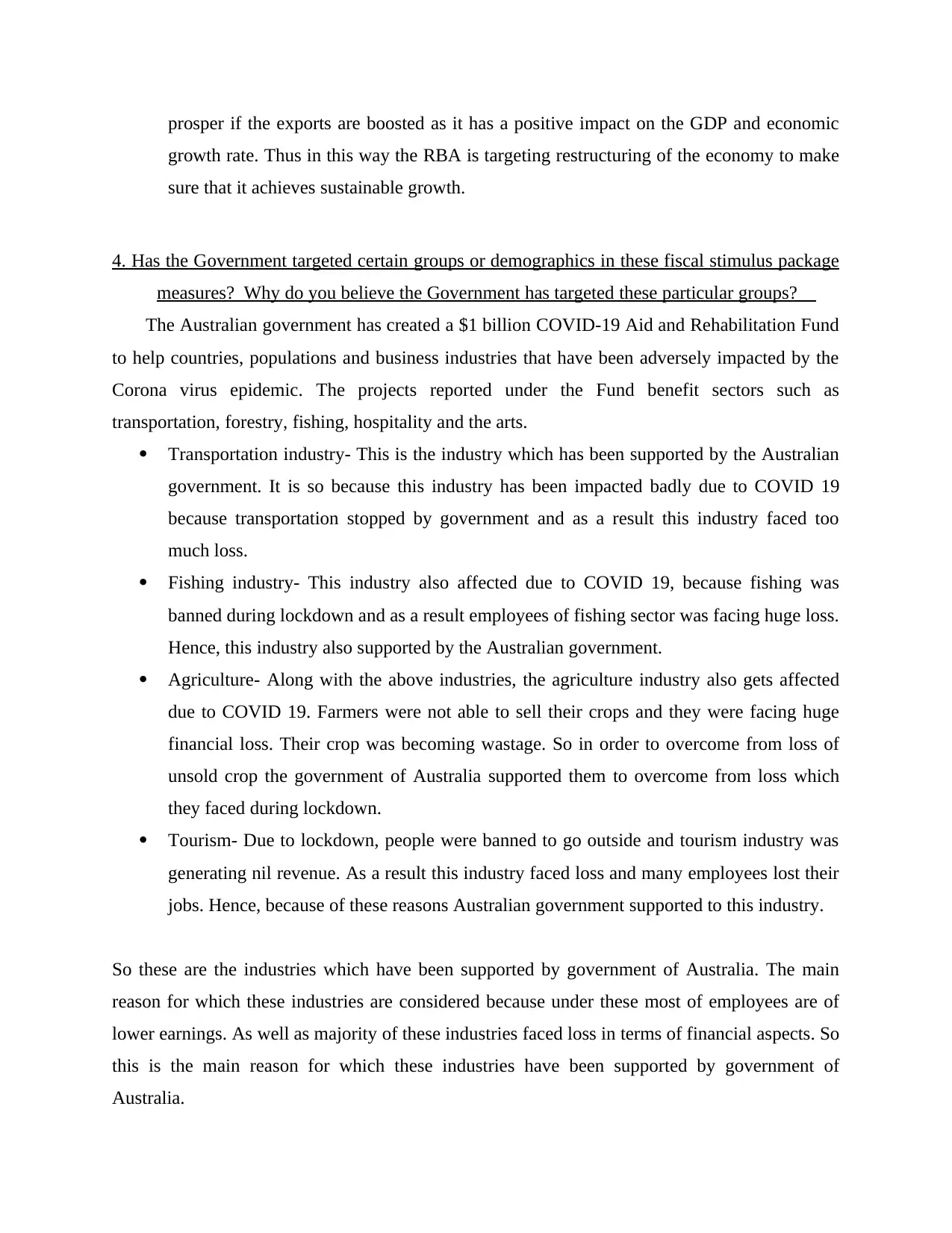
prosper if the exports are boosted as it has a positive impact on the GDP and economic
growth rate. Thus in this way the RBA is targeting restructuring of the economy to make
sure that it achieves sustainable growth.
4. Has the Government targeted certain groups or demographics in these fiscal stimulus package
measures? Why do you believe the Government has targeted these particular groups?
The Australian government has created a $1 billion COVID-19 Aid and Rehabilitation Fund
to help countries, populations and business industries that have been adversely impacted by the
Corona virus epidemic. The projects reported under the Fund benefit sectors such as
transportation, forestry, fishing, hospitality and the arts.
Transportation industry- This is the industry which has been supported by the Australian
government. It is so because this industry has been impacted badly due to COVID 19
because transportation stopped by government and as a result this industry faced too
much loss.
Fishing industry- This industry also affected due to COVID 19, because fishing was
banned during lockdown and as a result employees of fishing sector was facing huge loss.
Hence, this industry also supported by the Australian government.
Agriculture- Along with the above industries, the agriculture industry also gets affected
due to COVID 19. Farmers were not able to sell their crops and they were facing huge
financial loss. Their crop was becoming wastage. So in order to overcome from loss of
unsold crop the government of Australia supported them to overcome from loss which
they faced during lockdown.
Tourism- Due to lockdown, people were banned to go outside and tourism industry was
generating nil revenue. As a result this industry faced loss and many employees lost their
jobs. Hence, because of these reasons Australian government supported to this industry.
So these are the industries which have been supported by government of Australia. The main
reason for which these industries are considered because under these most of employees are of
lower earnings. As well as majority of these industries faced loss in terms of financial aspects. So
this is the main reason for which these industries have been supported by government of
Australia.
growth rate. Thus in this way the RBA is targeting restructuring of the economy to make
sure that it achieves sustainable growth.
4. Has the Government targeted certain groups or demographics in these fiscal stimulus package
measures? Why do you believe the Government has targeted these particular groups?
The Australian government has created a $1 billion COVID-19 Aid and Rehabilitation Fund
to help countries, populations and business industries that have been adversely impacted by the
Corona virus epidemic. The projects reported under the Fund benefit sectors such as
transportation, forestry, fishing, hospitality and the arts.
Transportation industry- This is the industry which has been supported by the Australian
government. It is so because this industry has been impacted badly due to COVID 19
because transportation stopped by government and as a result this industry faced too
much loss.
Fishing industry- This industry also affected due to COVID 19, because fishing was
banned during lockdown and as a result employees of fishing sector was facing huge loss.
Hence, this industry also supported by the Australian government.
Agriculture- Along with the above industries, the agriculture industry also gets affected
due to COVID 19. Farmers were not able to sell their crops and they were facing huge
financial loss. Their crop was becoming wastage. So in order to overcome from loss of
unsold crop the government of Australia supported them to overcome from loss which
they faced during lockdown.
Tourism- Due to lockdown, people were banned to go outside and tourism industry was
generating nil revenue. As a result this industry faced loss and many employees lost their
jobs. Hence, because of these reasons Australian government supported to this industry.
So these are the industries which have been supported by government of Australia. The main
reason for which these industries are considered because under these most of employees are of
lower earnings. As well as majority of these industries faced loss in terms of financial aspects. So
this is the main reason for which these industries have been supported by government of
Australia.
⊘ This is a preview!⊘
Do you want full access?
Subscribe today to unlock all pages.

Trusted by 1+ million students worldwide
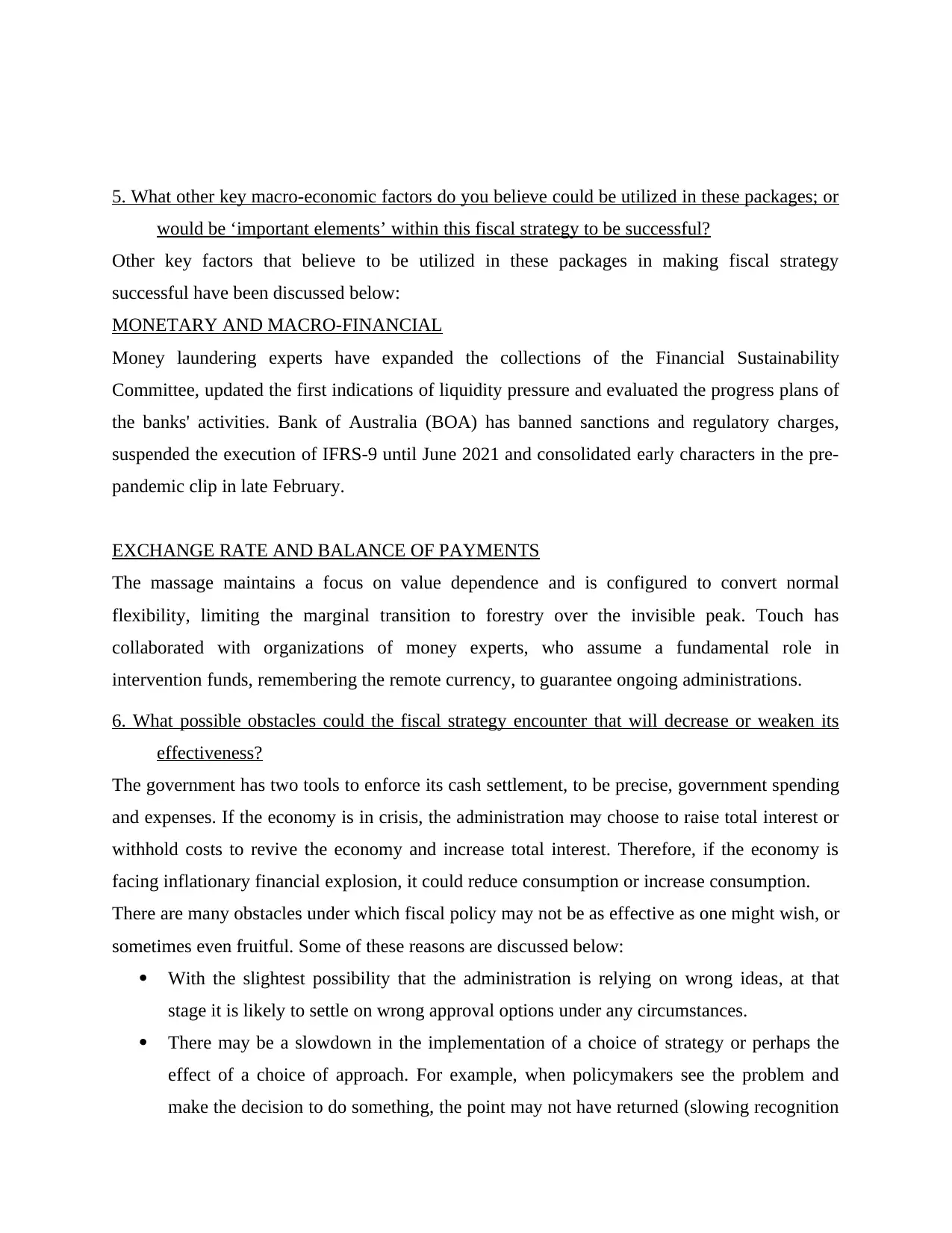
5. What other key macro-economic factors do you believe could be utilized in these packages; or
would be ‘important elements’ within this fiscal strategy to be successful?
Other key factors that believe to be utilized in these packages in making fiscal strategy
successful have been discussed below:
MONETARY AND MACRO-FINANCIAL
Money laundering experts have expanded the collections of the Financial Sustainability
Committee, updated the first indications of liquidity pressure and evaluated the progress plans of
the banks' activities. Bank of Australia (BOA) has banned sanctions and regulatory charges,
suspended the execution of IFRS-9 until June 2021 and consolidated early characters in the pre-
pandemic clip in late February.
EXCHANGE RATE AND BALANCE OF PAYMENTS
The massage maintains a focus on value dependence and is configured to convert normal
flexibility, limiting the marginal transition to forestry over the invisible peak. Touch has
collaborated with organizations of money experts, who assume a fundamental role in
intervention funds, remembering the remote currency, to guarantee ongoing administrations.
6. What possible obstacles could the fiscal strategy encounter that will decrease or weaken its
effectiveness?
The government has two tools to enforce its cash settlement, to be precise, government spending
and expenses. If the economy is in crisis, the administration may choose to raise total interest or
withhold costs to revive the economy and increase total interest. Therefore, if the economy is
facing inflationary financial explosion, it could reduce consumption or increase consumption.
There are many obstacles under which fiscal policy may not be as effective as one might wish, or
sometimes even fruitful. Some of these reasons are discussed below:
With the slightest possibility that the administration is relying on wrong ideas, at that
stage it is likely to settle on wrong approval options under any circumstances.
There may be a slowdown in the implementation of a choice of strategy or perhaps the
effect of a choice of approach. For example, when policymakers see the problem and
make the decision to do something, the point may not have returned (slowing recognition
would be ‘important elements’ within this fiscal strategy to be successful?
Other key factors that believe to be utilized in these packages in making fiscal strategy
successful have been discussed below:
MONETARY AND MACRO-FINANCIAL
Money laundering experts have expanded the collections of the Financial Sustainability
Committee, updated the first indications of liquidity pressure and evaluated the progress plans of
the banks' activities. Bank of Australia (BOA) has banned sanctions and regulatory charges,
suspended the execution of IFRS-9 until June 2021 and consolidated early characters in the pre-
pandemic clip in late February.
EXCHANGE RATE AND BALANCE OF PAYMENTS
The massage maintains a focus on value dependence and is configured to convert normal
flexibility, limiting the marginal transition to forestry over the invisible peak. Touch has
collaborated with organizations of money experts, who assume a fundamental role in
intervention funds, remembering the remote currency, to guarantee ongoing administrations.
6. What possible obstacles could the fiscal strategy encounter that will decrease or weaken its
effectiveness?
The government has two tools to enforce its cash settlement, to be precise, government spending
and expenses. If the economy is in crisis, the administration may choose to raise total interest or
withhold costs to revive the economy and increase total interest. Therefore, if the economy is
facing inflationary financial explosion, it could reduce consumption or increase consumption.
There are many obstacles under which fiscal policy may not be as effective as one might wish, or
sometimes even fruitful. Some of these reasons are discussed below:
With the slightest possibility that the administration is relying on wrong ideas, at that
stage it is likely to settle on wrong approval options under any circumstances.
There may be a slowdown in the implementation of a choice of strategy or perhaps the
effect of a choice of approach. For example, when policymakers see the problem and
make the decision to do something, the point may not have returned (slowing recognition
Paraphrase This Document
Need a fresh take? Get an instant paraphrase of this document with our AI Paraphraser
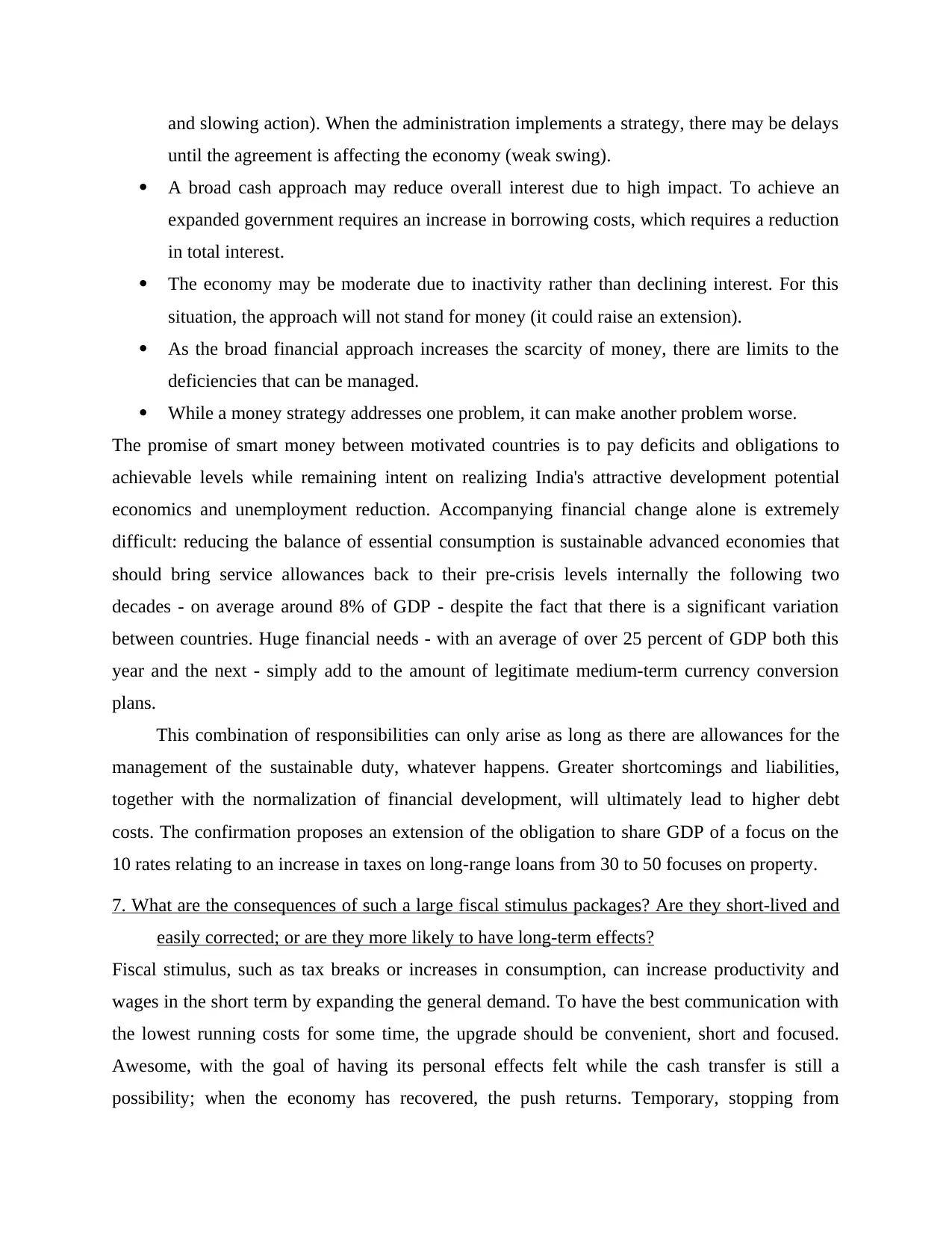
and slowing action). When the administration implements a strategy, there may be delays
until the agreement is affecting the economy (weak swing).
A broad cash approach may reduce overall interest due to high impact. To achieve an
expanded government requires an increase in borrowing costs, which requires a reduction
in total interest.
The economy may be moderate due to inactivity rather than declining interest. For this
situation, the approach will not stand for money (it could raise an extension).
As the broad financial approach increases the scarcity of money, there are limits to the
deficiencies that can be managed.
While a money strategy addresses one problem, it can make another problem worse.
The promise of smart money between motivated countries is to pay deficits and obligations to
achievable levels while remaining intent on realizing India's attractive development potential
economics and unemployment reduction. Accompanying financial change alone is extremely
difficult: reducing the balance of essential consumption is sustainable advanced economies that
should bring service allowances back to their pre-crisis levels internally the following two
decades - on average around 8% of GDP - despite the fact that there is a significant variation
between countries. Huge financial needs - with an average of over 25 percent of GDP both this
year and the next - simply add to the amount of legitimate medium-term currency conversion
plans.
This combination of responsibilities can only arise as long as there are allowances for the
management of the sustainable duty, whatever happens. Greater shortcomings and liabilities,
together with the normalization of financial development, will ultimately lead to higher debt
costs. The confirmation proposes an extension of the obligation to share GDP of a focus on the
10 rates relating to an increase in taxes on long-range loans from 30 to 50 focuses on property.
7. What are the consequences of such a large fiscal stimulus packages? Are they short-lived and
easily corrected; or are they more likely to have long-term effects?
Fiscal stimulus, such as tax breaks or increases in consumption, can increase productivity and
wages in the short term by expanding the general demand. To have the best communication with
the lowest running costs for some time, the upgrade should be convenient, short and focused.
Awesome, with the goal of having its personal effects felt while the cash transfer is still a
possibility; when the economy has recovered, the push returns. Temporary, stopping from
until the agreement is affecting the economy (weak swing).
A broad cash approach may reduce overall interest due to high impact. To achieve an
expanded government requires an increase in borrowing costs, which requires a reduction
in total interest.
The economy may be moderate due to inactivity rather than declining interest. For this
situation, the approach will not stand for money (it could raise an extension).
As the broad financial approach increases the scarcity of money, there are limits to the
deficiencies that can be managed.
While a money strategy addresses one problem, it can make another problem worse.
The promise of smart money between motivated countries is to pay deficits and obligations to
achievable levels while remaining intent on realizing India's attractive development potential
economics and unemployment reduction. Accompanying financial change alone is extremely
difficult: reducing the balance of essential consumption is sustainable advanced economies that
should bring service allowances back to their pre-crisis levels internally the following two
decades - on average around 8% of GDP - despite the fact that there is a significant variation
between countries. Huge financial needs - with an average of over 25 percent of GDP both this
year and the next - simply add to the amount of legitimate medium-term currency conversion
plans.
This combination of responsibilities can only arise as long as there are allowances for the
management of the sustainable duty, whatever happens. Greater shortcomings and liabilities,
together with the normalization of financial development, will ultimately lead to higher debt
costs. The confirmation proposes an extension of the obligation to share GDP of a focus on the
10 rates relating to an increase in taxes on long-range loans from 30 to 50 focuses on property.
7. What are the consequences of such a large fiscal stimulus packages? Are they short-lived and
easily corrected; or are they more likely to have long-term effects?
Fiscal stimulus, such as tax breaks or increases in consumption, can increase productivity and
wages in the short term by expanding the general demand. To have the best communication with
the lowest running costs for some time, the upgrade should be convenient, short and focused.
Awesome, with the goal of having its personal effects felt while the cash transfer is still a
possibility; when the economy has recovered, the push returns. Temporary, stopping from
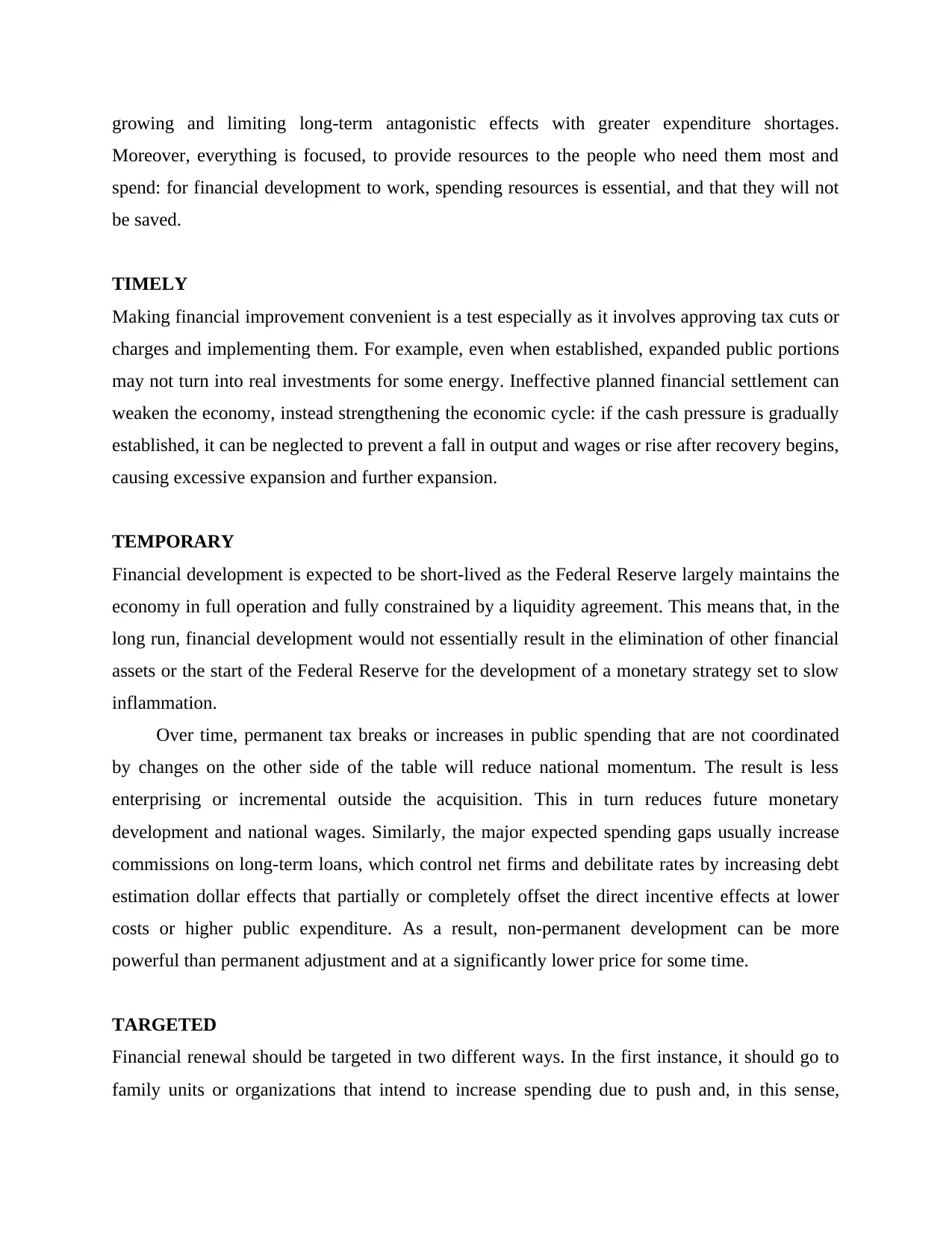
growing and limiting long-term antagonistic effects with greater expenditure shortages.
Moreover, everything is focused, to provide resources to the people who need them most and
spend: for financial development to work, spending resources is essential, and that they will not
be saved.
TIMELY
Making financial improvement convenient is a test especially as it involves approving tax cuts or
charges and implementing them. For example, even when established, expanded public portions
may not turn into real investments for some energy. Ineffective planned financial settlement can
weaken the economy, instead strengthening the economic cycle: if the cash pressure is gradually
established, it can be neglected to prevent a fall in output and wages or rise after recovery begins,
causing excessive expansion and further expansion.
TEMPORARY
Financial development is expected to be short-lived as the Federal Reserve largely maintains the
economy in full operation and fully constrained by a liquidity agreement. This means that, in the
long run, financial development would not essentially result in the elimination of other financial
assets or the start of the Federal Reserve for the development of a monetary strategy set to slow
inflammation.
Over time, permanent tax breaks or increases in public spending that are not coordinated
by changes on the other side of the table will reduce national momentum. The result is less
enterprising or incremental outside the acquisition. This in turn reduces future monetary
development and national wages. Similarly, the major expected spending gaps usually increase
commissions on long-term loans, which control net firms and debilitate rates by increasing debt
estimation dollar effects that partially or completely offset the direct incentive effects at lower
costs or higher public expenditure. As a result, non-permanent development can be more
powerful than permanent adjustment and at a significantly lower price for some time.
TARGETED
Financial renewal should be targeted in two different ways. In the first instance, it should go to
family units or organizations that intend to increase spending due to push and, in this sense,
Moreover, everything is focused, to provide resources to the people who need them most and
spend: for financial development to work, spending resources is essential, and that they will not
be saved.
TIMELY
Making financial improvement convenient is a test especially as it involves approving tax cuts or
charges and implementing them. For example, even when established, expanded public portions
may not turn into real investments for some energy. Ineffective planned financial settlement can
weaken the economy, instead strengthening the economic cycle: if the cash pressure is gradually
established, it can be neglected to prevent a fall in output and wages or rise after recovery begins,
causing excessive expansion and further expansion.
TEMPORARY
Financial development is expected to be short-lived as the Federal Reserve largely maintains the
economy in full operation and fully constrained by a liquidity agreement. This means that, in the
long run, financial development would not essentially result in the elimination of other financial
assets or the start of the Federal Reserve for the development of a monetary strategy set to slow
inflammation.
Over time, permanent tax breaks or increases in public spending that are not coordinated
by changes on the other side of the table will reduce national momentum. The result is less
enterprising or incremental outside the acquisition. This in turn reduces future monetary
development and national wages. Similarly, the major expected spending gaps usually increase
commissions on long-term loans, which control net firms and debilitate rates by increasing debt
estimation dollar effects that partially or completely offset the direct incentive effects at lower
costs or higher public expenditure. As a result, non-permanent development can be more
powerful than permanent adjustment and at a significantly lower price for some time.
TARGETED
Financial renewal should be targeted in two different ways. In the first instance, it should go to
family units or organizations that intend to increase spending due to push and, in this sense,
⊘ This is a preview!⊘
Do you want full access?
Subscribe today to unlock all pages.

Trusted by 1+ million students worldwide
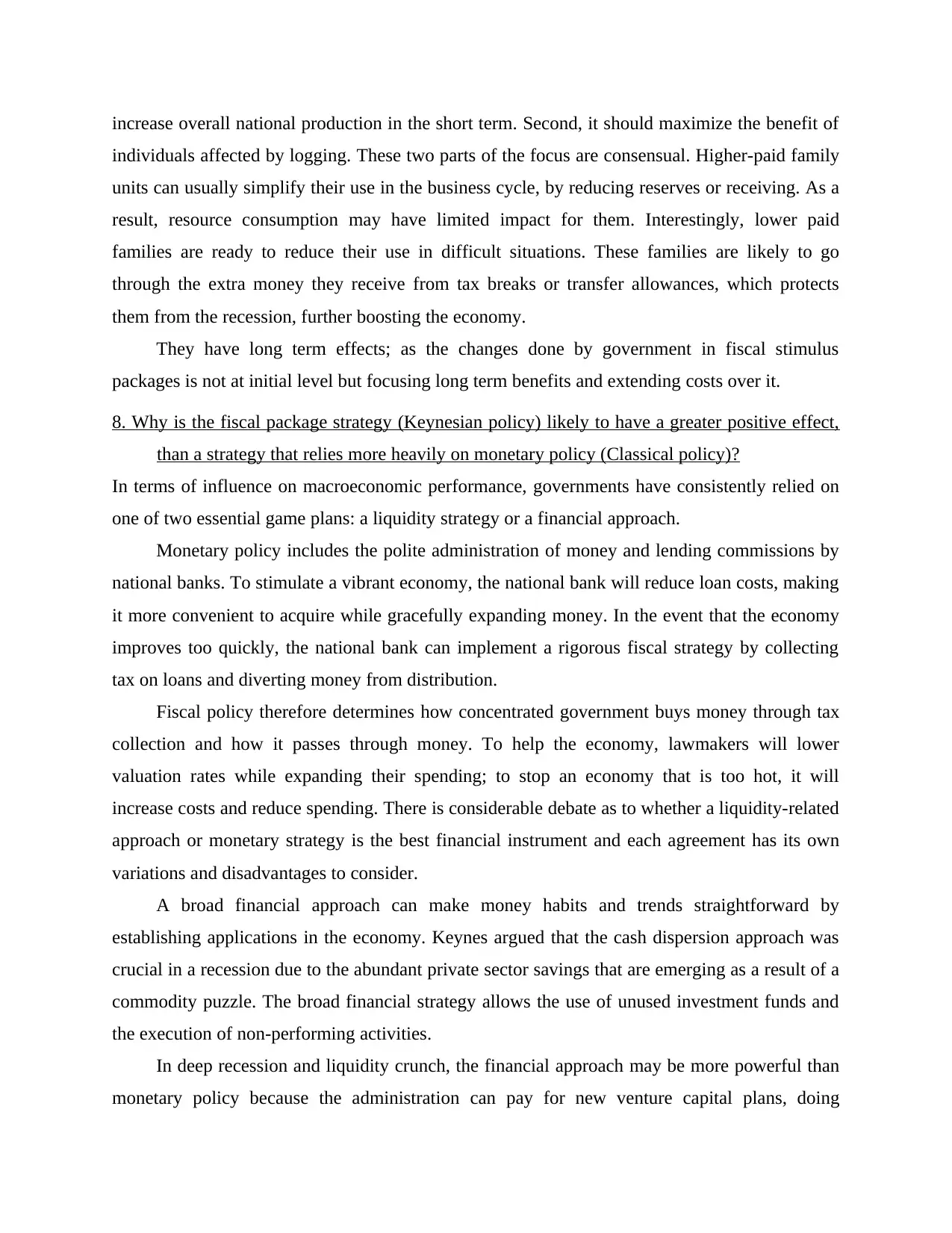
increase overall national production in the short term. Second, it should maximize the benefit of
individuals affected by logging. These two parts of the focus are consensual. Higher-paid family
units can usually simplify their use in the business cycle, by reducing reserves or receiving. As a
result, resource consumption may have limited impact for them. Interestingly, lower paid
families are ready to reduce their use in difficult situations. These families are likely to go
through the extra money they receive from tax breaks or transfer allowances, which protects
them from the recession, further boosting the economy.
They have long term effects; as the changes done by government in fiscal stimulus
packages is not at initial level but focusing long term benefits and extending costs over it.
8. Why is the fiscal package strategy (Keynesian policy) likely to have a greater positive effect,
than a strategy that relies more heavily on monetary policy (Classical policy)?
In terms of influence on macroeconomic performance, governments have consistently relied on
one of two essential game plans: a liquidity strategy or a financial approach.
Monetary policy includes the polite administration of money and lending commissions by
national banks. To stimulate a vibrant economy, the national bank will reduce loan costs, making
it more convenient to acquire while gracefully expanding money. In the event that the economy
improves too quickly, the national bank can implement a rigorous fiscal strategy by collecting
tax on loans and diverting money from distribution.
Fiscal policy therefore determines how concentrated government buys money through tax
collection and how it passes through money. To help the economy, lawmakers will lower
valuation rates while expanding their spending; to stop an economy that is too hot, it will
increase costs and reduce spending. There is considerable debate as to whether a liquidity-related
approach or monetary strategy is the best financial instrument and each agreement has its own
variations and disadvantages to consider.
A broad financial approach can make money habits and trends straightforward by
establishing applications in the economy. Keynes argued that the cash dispersion approach was
crucial in a recession due to the abundant private sector savings that are emerging as a result of a
commodity puzzle. The broad financial strategy allows the use of unused investment funds and
the execution of non-performing activities.
In deep recession and liquidity crunch, the financial approach may be more powerful than
monetary policy because the administration can pay for new venture capital plans, doing
individuals affected by logging. These two parts of the focus are consensual. Higher-paid family
units can usually simplify their use in the business cycle, by reducing reserves or receiving. As a
result, resource consumption may have limited impact for them. Interestingly, lower paid
families are ready to reduce their use in difficult situations. These families are likely to go
through the extra money they receive from tax breaks or transfer allowances, which protects
them from the recession, further boosting the economy.
They have long term effects; as the changes done by government in fiscal stimulus
packages is not at initial level but focusing long term benefits and extending costs over it.
8. Why is the fiscal package strategy (Keynesian policy) likely to have a greater positive effect,
than a strategy that relies more heavily on monetary policy (Classical policy)?
In terms of influence on macroeconomic performance, governments have consistently relied on
one of two essential game plans: a liquidity strategy or a financial approach.
Monetary policy includes the polite administration of money and lending commissions by
national banks. To stimulate a vibrant economy, the national bank will reduce loan costs, making
it more convenient to acquire while gracefully expanding money. In the event that the economy
improves too quickly, the national bank can implement a rigorous fiscal strategy by collecting
tax on loans and diverting money from distribution.
Fiscal policy therefore determines how concentrated government buys money through tax
collection and how it passes through money. To help the economy, lawmakers will lower
valuation rates while expanding their spending; to stop an economy that is too hot, it will
increase costs and reduce spending. There is considerable debate as to whether a liquidity-related
approach or monetary strategy is the best financial instrument and each agreement has its own
variations and disadvantages to consider.
A broad financial approach can make money habits and trends straightforward by
establishing applications in the economy. Keynes argued that the cash dispersion approach was
crucial in a recession due to the abundant private sector savings that are emerging as a result of a
commodity puzzle. The broad financial strategy allows the use of unused investment funds and
the execution of non-performing activities.
In deep recession and liquidity crunch, the financial approach may be more powerful than
monetary policy because the administration can pay for new venture capital plans, doing
Paraphrase This Document
Need a fresh take? Get an instant paraphrase of this document with our AI Paraphraser
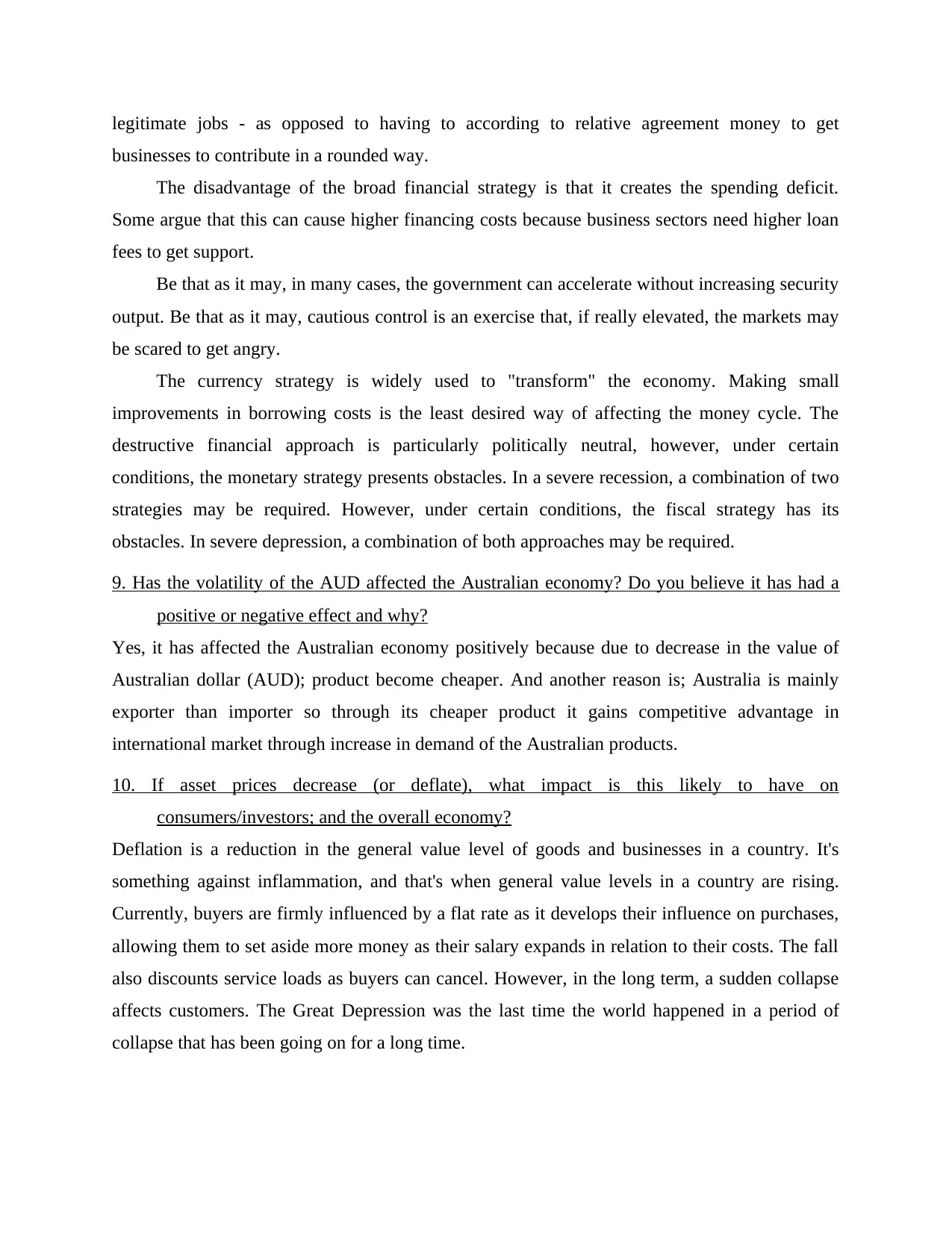
legitimate jobs - as opposed to having to according to relative agreement money to get
businesses to contribute in a rounded way.
The disadvantage of the broad financial strategy is that it creates the spending deficit.
Some argue that this can cause higher financing costs because business sectors need higher loan
fees to get support.
Be that as it may, in many cases, the government can accelerate without increasing security
output. Be that as it may, cautious control is an exercise that, if really elevated, the markets may
be scared to get angry.
The currency strategy is widely used to "transform" the economy. Making small
improvements in borrowing costs is the least desired way of affecting the money cycle. The
destructive financial approach is particularly politically neutral, however, under certain
conditions, the monetary strategy presents obstacles. In a severe recession, a combination of two
strategies may be required. However, under certain conditions, the fiscal strategy has its
obstacles. In severe depression, a combination of both approaches may be required.
9. Has the volatility of the AUD affected the Australian economy? Do you believe it has had a
positive or negative effect and why?
Yes, it has affected the Australian economy positively because due to decrease in the value of
Australian dollar (AUD); product become cheaper. And another reason is; Australia is mainly
exporter than importer so through its cheaper product it gains competitive advantage in
international market through increase in demand of the Australian products.
10. If asset prices decrease (or deflate), what impact is this likely to have on
consumers/investors; and the overall economy?
Deflation is a reduction in the general value level of goods and businesses in a country. It's
something against inflammation, and that's when general value levels in a country are rising.
Currently, buyers are firmly influenced by a flat rate as it develops their influence on purchases,
allowing them to set aside more money as their salary expands in relation to their costs. The fall
also discounts service loads as buyers can cancel. However, in the long term, a sudden collapse
affects customers. The Great Depression was the last time the world happened in a period of
collapse that has been going on for a long time.
businesses to contribute in a rounded way.
The disadvantage of the broad financial strategy is that it creates the spending deficit.
Some argue that this can cause higher financing costs because business sectors need higher loan
fees to get support.
Be that as it may, in many cases, the government can accelerate without increasing security
output. Be that as it may, cautious control is an exercise that, if really elevated, the markets may
be scared to get angry.
The currency strategy is widely used to "transform" the economy. Making small
improvements in borrowing costs is the least desired way of affecting the money cycle. The
destructive financial approach is particularly politically neutral, however, under certain
conditions, the monetary strategy presents obstacles. In a severe recession, a combination of two
strategies may be required. However, under certain conditions, the fiscal strategy has its
obstacles. In severe depression, a combination of both approaches may be required.
9. Has the volatility of the AUD affected the Australian economy? Do you believe it has had a
positive or negative effect and why?
Yes, it has affected the Australian economy positively because due to decrease in the value of
Australian dollar (AUD); product become cheaper. And another reason is; Australia is mainly
exporter than importer so through its cheaper product it gains competitive advantage in
international market through increase in demand of the Australian products.
10. If asset prices decrease (or deflate), what impact is this likely to have on
consumers/investors; and the overall economy?
Deflation is a reduction in the general value level of goods and businesses in a country. It's
something against inflammation, and that's when general value levels in a country are rising.
Currently, buyers are firmly influenced by a flat rate as it develops their influence on purchases,
allowing them to set aside more money as their salary expands in relation to their costs. The fall
also discounts service loads as buyers can cancel. However, in the long term, a sudden collapse
affects customers. The Great Depression was the last time the world happened in a period of
collapse that has been going on for a long time.
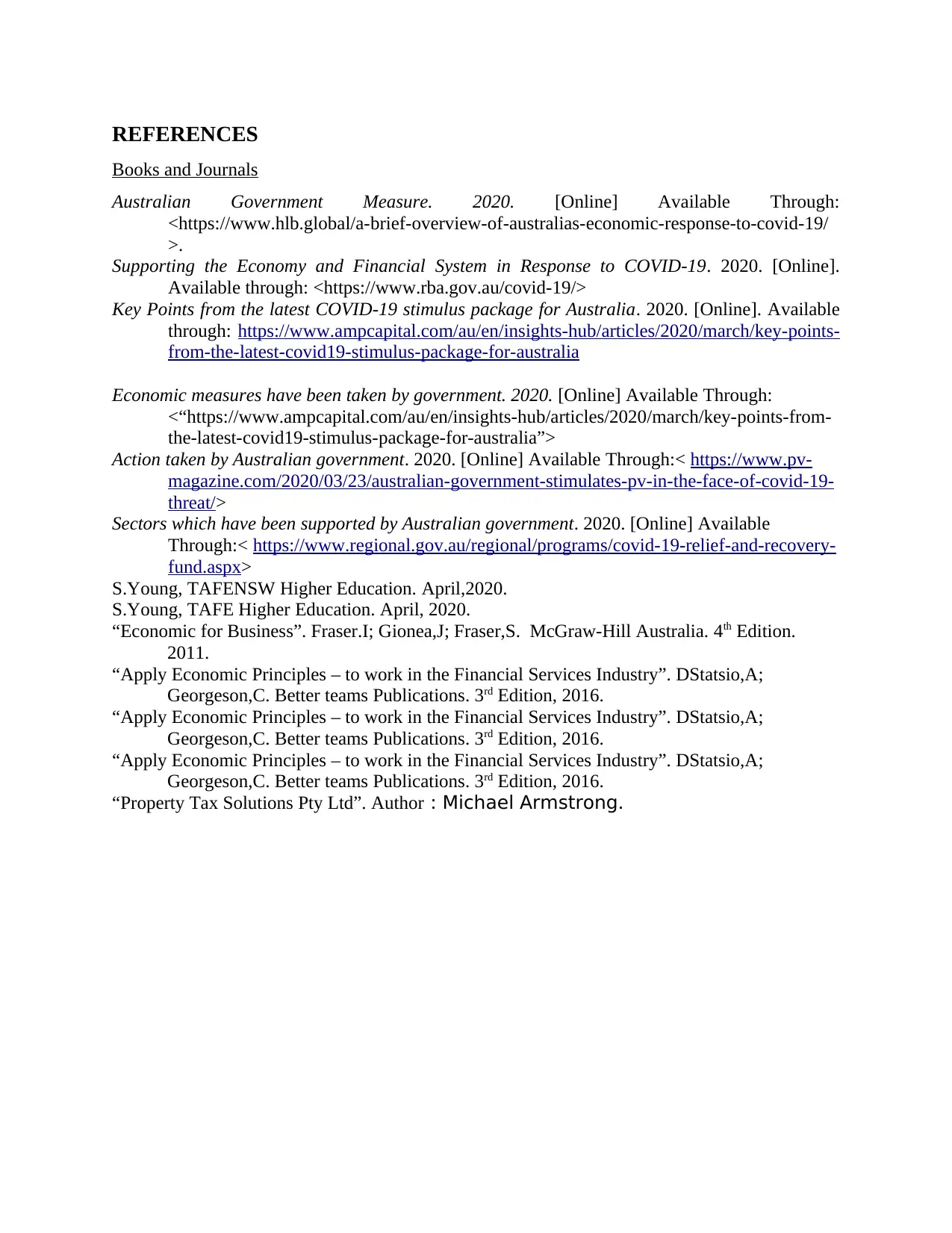
REFERENCES
Books and Journals
Australian Government Measure. 2020. [Online] Available Through:
<https://www.hlb.global/a-brief-overview-of-australias-economic-response-to-covid-19/
>.
Supporting the Economy and Financial System in Response to COVID-19. 2020. [Online].
Available through: <https://www.rba.gov.au/covid-19/>
Key Points from the latest COVID-19 stimulus package for Australia. 2020. [Online]. Available
through: https://www.ampcapital.com/au/en/insights-hub/articles/2020/march/key-points-
from-the-latest-covid19-stimulus-package-for-australia
Economic measures have been taken by government. 2020. [Online] Available Through:
<“https://www.ampcapital.com/au/en/insights-hub/articles/2020/march/key-points-from-
the-latest-covid19-stimulus-package-for-australia”>
Action taken by Australian government. 2020. [Online] Available Through:< https://www.pv-
magazine.com/2020/03/23/australian-government-stimulates-pv-in-the-face-of-covid-19-
threat/>
Sectors which have been supported by Australian government. 2020. [Online] Available
Through:< https://www.regional.gov.au/regional/programs/covid-19-relief-and-recovery-
fund.aspx>
S.Young, TAFENSW Higher Education. April,2020.
S.Young, TAFE Higher Education. April, 2020.
“Economic for Business”. Fraser.I; Gionea,J; Fraser,S. McGraw-Hill Australia. 4th Edition.
2011.
“Apply Economic Principles – to work in the Financial Services Industry”. DStatsio,A;
Georgeson,C. Better teams Publications. 3rd Edition, 2016.
“Apply Economic Principles – to work in the Financial Services Industry”. DStatsio,A;
Georgeson,C. Better teams Publications. 3rd Edition, 2016.
“Apply Economic Principles – to work in the Financial Services Industry”. DStatsio,A;
Georgeson,C. Better teams Publications. 3rd Edition, 2016.
“Property Tax Solutions Pty Ltd”. Author : Michael Armstrong.
Books and Journals
Australian Government Measure. 2020. [Online] Available Through:
<https://www.hlb.global/a-brief-overview-of-australias-economic-response-to-covid-19/
>.
Supporting the Economy and Financial System in Response to COVID-19. 2020. [Online].
Available through: <https://www.rba.gov.au/covid-19/>
Key Points from the latest COVID-19 stimulus package for Australia. 2020. [Online]. Available
through: https://www.ampcapital.com/au/en/insights-hub/articles/2020/march/key-points-
from-the-latest-covid19-stimulus-package-for-australia
Economic measures have been taken by government. 2020. [Online] Available Through:
<“https://www.ampcapital.com/au/en/insights-hub/articles/2020/march/key-points-from-
the-latest-covid19-stimulus-package-for-australia”>
Action taken by Australian government. 2020. [Online] Available Through:< https://www.pv-
magazine.com/2020/03/23/australian-government-stimulates-pv-in-the-face-of-covid-19-
threat/>
Sectors which have been supported by Australian government. 2020. [Online] Available
Through:< https://www.regional.gov.au/regional/programs/covid-19-relief-and-recovery-
fund.aspx>
S.Young, TAFENSW Higher Education. April,2020.
S.Young, TAFE Higher Education. April, 2020.
“Economic for Business”. Fraser.I; Gionea,J; Fraser,S. McGraw-Hill Australia. 4th Edition.
2011.
“Apply Economic Principles – to work in the Financial Services Industry”. DStatsio,A;
Georgeson,C. Better teams Publications. 3rd Edition, 2016.
“Apply Economic Principles – to work in the Financial Services Industry”. DStatsio,A;
Georgeson,C. Better teams Publications. 3rd Edition, 2016.
“Apply Economic Principles – to work in the Financial Services Industry”. DStatsio,A;
Georgeson,C. Better teams Publications. 3rd Edition, 2016.
“Property Tax Solutions Pty Ltd”. Author : Michael Armstrong.
⊘ This is a preview!⊘
Do you want full access?
Subscribe today to unlock all pages.

Trusted by 1+ million students worldwide
1 out of 13
Your All-in-One AI-Powered Toolkit for Academic Success.
+13062052269
info@desklib.com
Available 24*7 on WhatsApp / Email
![[object Object]](/_next/static/media/star-bottom.7253800d.svg)
Unlock your academic potential
Copyright © 2020–2025 A2Z Services. All Rights Reserved. Developed and managed by ZUCOL.
